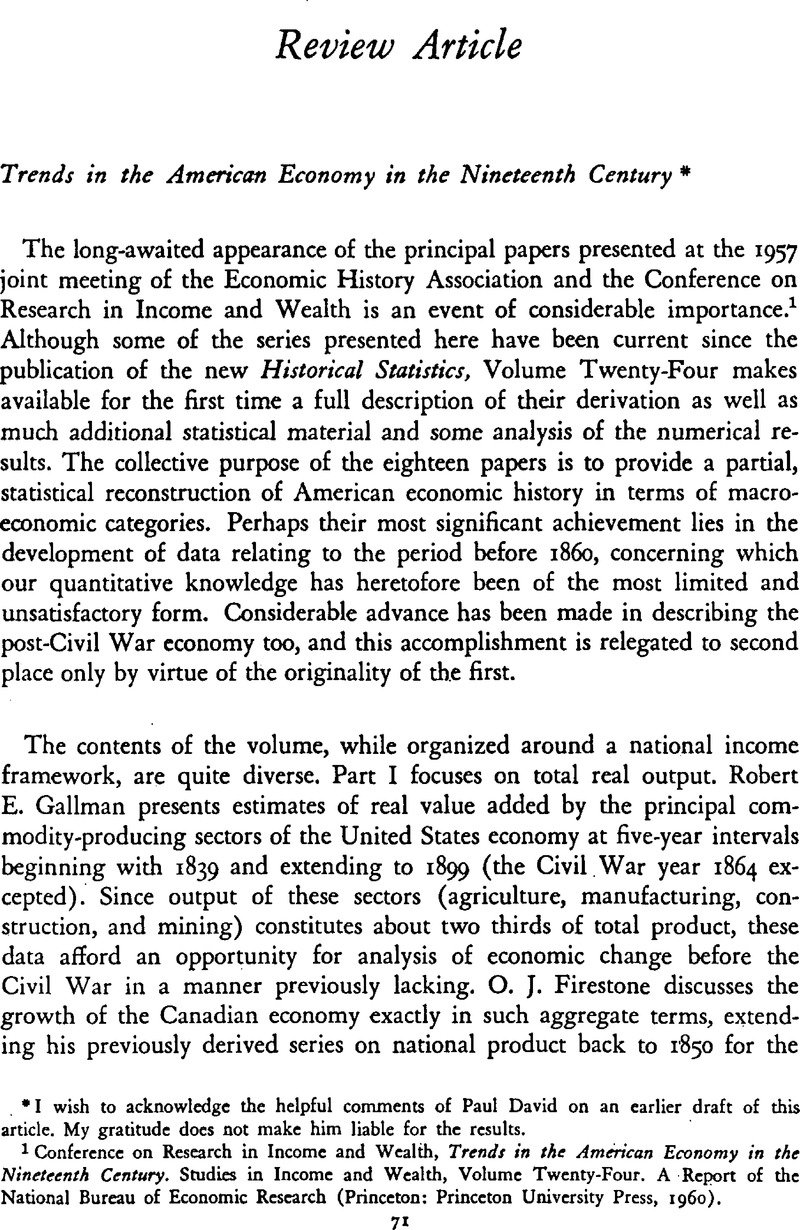Article contents
Trends in the American Economy in the Nineteenth Century*
Published online by Cambridge University Press: 03 February 2011
Abstract

- Type
- Review Article
- Information
- Copyright
- Copyright © The Economic History Association 1962
References
1 Conference on Research in Income and Wealth, Trends in the American Economy in the Nineteenth Century. Studies in Income and Wealth, Volume Twenty-Four. A Report of the National Bureau of Economic Research (Princeton: Princeton University Press, 1960).Google Scholar
2 Martin, Robert F., National Income in the United States, 1799-1938 (New York: National Industrial Conference Board, 1939)Google Scholar and King, Willford I., The Wealth and Income of the People of the United States (New York: Macmillan, 1915)Google Scholar both are based predominantly on census materials, albeit imperfectly, and show a decline in per capita income in constant dollars. David Wells is also convinced of retardation in his contemporary reports as Special Commissioner of the Revenue. But Edwin Frickey's indices of both manufacturing and transportation and communication activity, perhaps most relied upon previously as an indication of industrial prosperity, exhibit no markedly smaller rate of increase in the sixties than the seventies (Production in the United States, 1860-1914 (Cambridge: Harvard University Press, 1947)Google Scholar . Gallman's results are thus not without novelty.
3 This is not to ignore the very real possibility that the growth of production in the sixties may be understated and that in the seventies overstated, due in part to the underreporting in the Census of 1869. (New and interesting evidence on the latter decade is provided by Friedman, Milton, “Monetary Data and National Income Estimates,” Economic Development and Cultural Change, IX, No. 3 (04 1961), 267–86CrossRefGoogle Scholar .) But an allowance for such a possibility does not alter the relative position of the two periods in terms of the rate of advance, nor does it negate the fact that the expansion after the war occurred while prices were declining.
4 Kuznets, Simon, “Summary of Discussion and Postscript,” The Journal of Economic History, XVII, No. 4 (12 1957), 553.Google Scholar
5 Lebergott's real wage series moves differently from earlier compilations using the Aldrich Report, and Budd's results on labor's share are in marked contrast to King's earlier findings. Other instances could probably be enumerated as well. Parker and Whartenby focus upon the inadequate basis, indeed, the non-reproducibility, of Martin's pre-1840 income statistics.
6 Exceptions to these generalizations occur when it is possible to derive the desired results by a sampling process. This may take the form either of direct extension from a sample to a population total or the intermediate calculation of a multivariate relationship to estimate missing observations for which certain information exists. Although Cranmer does employ the latter technique, it is not common to this volume as a whole nor to historical estimation in general. More could possibly be done with it. Nor is random sampling very typical. In moving from scattered wage estimates to global trends, for example, there is imputation of a priori notions concerning the structure of the labor market and hence substantive assumptions. In this instance the assumptions are derived from the period at hand, however, a practice commented upon presently.
7 At a more elementary level than that suggested here, limited and less useful bounds couldi be easily secured. Instead of taking the calculated x, y relationship of the later period as exact which it often is not, the variation of this would give rise to differing estimates of the unknown y for the earlier period.
8 In the principal instance in which this is done, however, Gallman's two estimates of construction value added, it is by no means clear except by the arithmetic of the result that they are alternative bounds.
9 The data can be affected by causes other than estimation of course, among which the most important is the process of deflation from current to constant dollars. This subject has been explored in detail elsewhere, which is the reason for its neglect here.
10 The method of averaging “C” coefficients leads to a distribution of expenditures which understates the proportion in the middle of the project. In addition, as Segal points out in his comment, constant and current dollars are confounded in the process.
- 2
- Cited by




